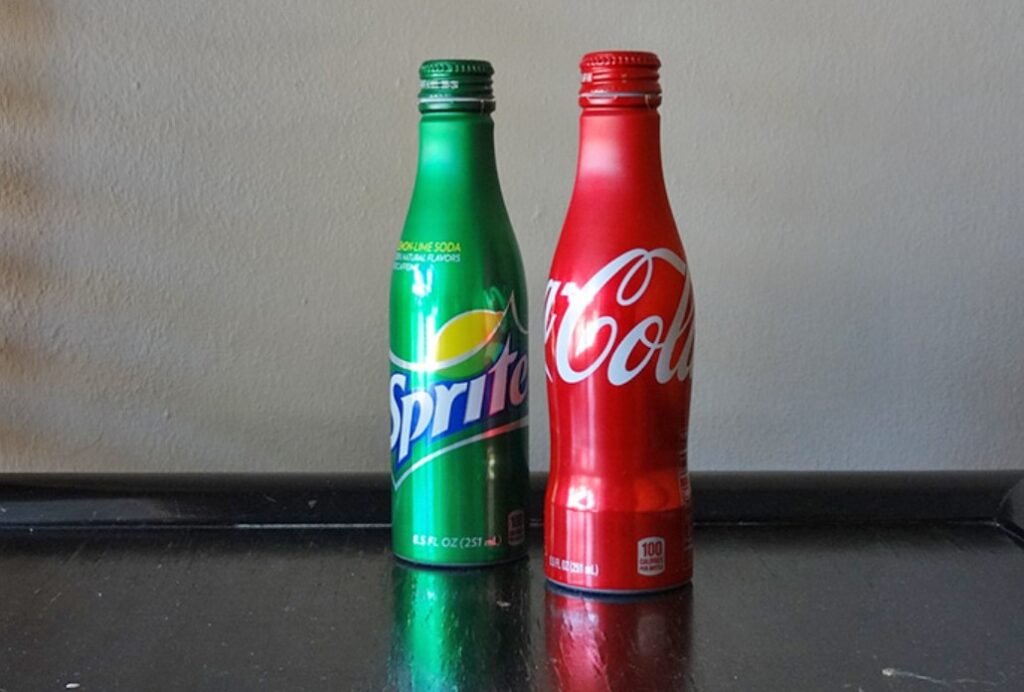As a seasoned expert in nutrition and health sciences, I’ve spent years studying the impacts of various foods and beverages on our bodies. One question that frequently comes up is about the health implications of popular sodas, specifically, Sprite and Coke. It’s a valid concern, considering how these beverages are a staple in many households.
Have you ever wondered, “Is Sprite healthier than Coke?” Well, the answer isn’t as straightforward as you might think. While Sprite lacks phosphoric acid and has fewer calories due to the addition of artificial sweeteners, it’s not necessarily a healthier choice. Both Sprite and Coke have high sugar content and lack nutritional value. By delving deeper into this topic, you’ll gain a clearer understanding of what these sodas contain and how they impact your health. So, let’s dive in and uncover the truth behind these fizzy drinks.
What’s in Your Soda: A Look at Ingredients
Soda, a beloved beverage worldwide, is more than just a refreshing drink. It’s a concoction of various ingredients, some of which have raised health concerns over the years. Let’s take a closer look at what you’re sipping on when you enjoy a can of soda.
- Carbonated Water: This is the primary ingredient in soda, making up about 90% of the content. It provides the fizzy sensation that many people love.
- Sweeteners: Sodas are notoriously high in sugar. The sweet taste primarily comes from high fructose corn syrup or sucrose. Diet sodas often use artificial sweeteners like aspartame.
- Acids: Citric and phosphoric acids are typically used in sodas. They add tartness and act as preservatives. Phosphoric acid is particularly common in colas, while citric acid is found in citrus-flavored drinks like Sprite.
- Caffeine: Many sodas contain caffeine, which has a stimulating effect. However, not all sodas are caffeinated.
- Colors and Flavors: To make sodas more appealing, manufacturers add colors and flavors. Caramel color is common, especially in colas. Natural and artificial flavors are also used.
Recent research indicates a link between soda consumption and several health issues. A study published in the Journal of the American Heart Association found that high consumption of sugary drinks, including soda, could contribute to an increased risk of heart disease. Other research suggests a link between diet sodas and an increased risk of stroke and dementia due to the artificial sweeteners used.
According to the Center for Science in the Public Interest, the average American consumes about 38.5 gallons of soda per year. This high consumption rate, coupled with the potential health risks associated with the ingredients in soda, underscores the importance of understanding what’s in your favorite fizzy beverages.
Dissecting Sprite: Nutritional Facts and Health Impact
Sprite, a lemon-lime flavored soda manufactured by the Coca-Cola company, is often seen as a lighter alternative to darker sodas like Coke. But what exactly does this bubbly beverage contain, and how does it impact your health? Let’s delve into the nutritional facts and health implications of Sprite.

A standard 12-ounce can of Sprite contains:
- Calories: 140
- Sugar: 38 grams
- Sodium: 65 milligrams
- Carbohydrates: 38 grams
Unlike Coke, Sprite doesn’t contain caffeine or phosphoric acid. The absence of these ingredients might make you think Sprite is a healthier option, but it’s not that simple.
The high sugar content in Sprite can have several health implications, particularly if consumed excessively. Consuming large amounts of added sugars, like those found in Sprite, can lead to weight gain, type 2 diabetes, heart disease, and tooth decay.
Moreover, while Sprite may not contain caffeine, it does contain a high amount of sodium. High sodium intake can lead to high blood pressure, a risk factor for heart disease and stroke.
To further complicate matters, Sprite, like many other sodas, doesn’t offer any essential nutrients. While it may provide temporary refreshment, it lacks vitamins, minerals, protein, and fiber — all crucial components of a healthy diet.
In essence, while Sprite might seem like a less harmful choice compared to some other sodas, it’s far from a healthy beverage. Regular consumption can contribute to numerous health issues, largely due to its high sugar and sodium content.
Coke Versus Sprite: Calories, Sugar, and Sodium Comparison
When it comes to choosing between Sprite and Coke, many people might base their decision on taste preference alone. However, if you’re concerned about your health, it’s worth comparing the nutritional content of these two popular sodas.
A standard 12-ounce can of Coke contains:
- Calories: 140
- Sugar: 39 grams
- Sodium: 45 milligrams
- Carbohydrates: 39 grams
As you can see, the calorie count for both Sprite and Coke is the same. However, Coke has slightly more sugar and fewer sodium than Sprite.
Now let’s consider the ingredients. Coke contains phosphoric acid and caffeine, while Sprite does not. Phosphoric acid is linked to bone loss and kidney disease, and caffeine can lead to insomnia, nervousness, and increased heart rate. However, Sprite has a higher sodium content, which can contribute to high blood pressure when consumed in excess.
In conclusion, neither Sprite nor Coke is a healthy beverage option due to their high sugar content and lack of essential nutrients. While Sprite may lack certain ingredients found in Coke, its higher sodium content presents its own health risks. It’s crucial to consider these factors when choosing a soda and remember that moderation is key.
The Role of Artificial Sweeteners in Sprite
While Sprite is known for its high sugar content, it’s important to note that some versions of the beverage use artificial sweeteners as a sugar substitute. Diet Sprite or Sprite Zero, for instance, uses artificial sweeteners to maintain the sweet taste while reducing the calorie count.
Artificial sweeteners, such as aspartame and acesulfame potassium, are commonly used in diet sodas. They provide the sweet taste without the calories associated with sugar. However, these sweeteners have sparked controversy over the years due to potential health risks.
Despite being approved for consumption by the Food and Drug Administration (FDA), some studies suggest potential negative effects of artificial sweeteners. These include an increased risk of metabolic syndrome, type 2 diabetes, and heart disease. Additionally, artificial sweeteners may disrupt the gut microbiota, which could negatively affect digestion and immunity.
On the other hand, it’s worth noting that these findings are not universally accepted, and more research is needed to conclusively determine the health impacts of artificial sweeteners. Therefore, while Sprite Zero and other diet sodas might seem like a healthier choice due to their lower calorie count, the potential health implications of artificial sweeteners should be taken into account.
How Phosphoric Acid in Coke Affects Your Health
Phosphoric acid is a key ingredient in many colas, including Coke. This chemical compound gives the beverage its characteristic tangy flavor and prevents the growth of molds and bacteria. However, it’s worth noting that phosphoric acid has been linked to several health concerns.
Ingesting large amounts of phosphoric acid can interfere with the body’s ability to absorb calcium, leading to weaker bones and teeth. A study published in the American Journal of Clinical Nutrition found that women who regularly consume cola-based sodas have lower bone density than those who do not. This is believed to be due to the high levels of phosphoric acid.
Moreover, phosphoric acid can contribute to kidney problems. A study in the journal Epidemiology found that consuming two or more colas per day (diet or regular) was associated with a twofold risk of chronic kidney disease.
While the occasional soda is unlikely to cause harm, frequent consumption of drinks high in phosphoric acid, such as Coke, may pose risks to your health. Therefore, it’s important to consider these potential implications when choosing your beverage.
Making Informed Choices: Healthier Alternatives to Sprite and Coke
When it comes to quenching your thirst or satisfying your craving for a fizzy beverage, Sprite and Coke may be the first options that come to mind. However, as we’ve discussed, these popular sodas come with their own set of health concerns. So, what are some healthier alternatives to these sugary drinks? Let’s explore a few options that can help you make informed choices about your beverage consumption.
- Water: The ultimate thirst quencher, water is calorie-free, hydrating, and essential for your body’s functions. Infuse it with fresh fruits or herbs for a flavor twist.
- Unsweetened Tea: Whether it’s green, black, or herbal, unsweetened tea offers a flavorful, calorie-free alternative to soda. It also provides antioxidants, which promote overall health.
- Seltzer Water: If you love the fizz but want to avoid the sugar and artificial ingredients, seltzer water is a great option. You can find varieties flavored with natural fruit essences.
- Homemade Lemonade: Made with fresh lemons, water, and a touch of honey or stevia, homemade lemonade can be a refreshing, lower-sugar alternative to Sprite.
- Smoothies: While not carbonated, smoothies made with whole fruits and vegetables can be a satisfying, nutrient-dense alternative to soda.
By choosing these healthier alternatives over sodas like Sprite and Coke, you can enjoy a refreshing drink without the excessive sugar and potential health risks. Remember, your beverage choices can have a significant impact on your overall health, so choose wisely!
Conclusion
In the world of fizzy beverages, Sprite and Coke have long been favorites. However, when we dissect their ingredients, we see a high content of sugars, sodium, and other elements that can pose health risks with excessive consumption. The good news is, being informed about what’s in these drinks enables us to make healthier choices.
There are plenty of refreshing alternatives to Sprite and Coke that provide satisfaction without the potential health hazards. From water infused with fresh fruits to homemade smoothies, your options are plentiful. Remember, a small change in your beverage choice can make a big difference in your overall health. So, next time you reach for a drink, choose wisely!
Frequently Asked Questions
1. How much sugar does a can of Sprite contain?
A 12-ounce can of Sprite contains approximately 38 grams of sugar.
2. Is Sprite healthier than Coke?
While Sprite doesn’t contain caffeine or phosphoric acid, it has a higher sodium content and nearly the same amount of sugar as Coke. Neither is a healthy beverage option due to their high sugar content and lack of essential nutrients.
3. What are some healthier alternatives to Sprite and Coke?
Water, unsweetened tea, seltzer water, homemade lemonade, and smoothies made with whole fruits and vegetables are healthier alternatives to Sprite and Coke.
4. What are the potential health risks of consuming too much phosphoric acid in Coke?
Excessive consumption of phosphoric acid, an ingredient in Coke, can lead to weaker bones and teeth, and increase the risk of kidney disease.
5. Are diet sodas a healthier choice?
Diet sodas like Sprite Zero use artificial sweeteners instead of sugar, reducing their calorie content. However, some research suggests potential health risks associated with artificial sweeteners, including an increased risk of metabolic syndrome, type 2 diabetes, and heart disease.
